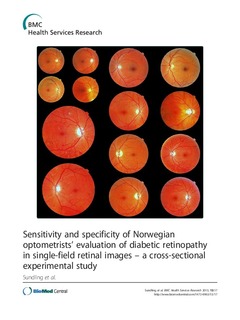| dc.contributor.author | Sundling, Vibeke | |
| dc.contributor.author | Gulbrandsen, Pål | |
| dc.contributor.author | Straand, Jørund | |
| dc.date.accessioned | 2014-02-17T09:05:10Z | |
| dc.date.available | 2014-02-17T09:05:10Z | |
| dc.date.issued | 2013 | |
| dc.identifier.citation | Sundling, V., Gulbrandsen, P., & Straand, J. (2013). Sensitivity and specificity of Norwegian optometrists' evaluation of diabetic retinopathy in single-field retinal images - a cross-sectional experimental study. BMC Health Services Research, 13, 1-8. doi: 10.1186/1472-6963-13-17 | no_NO |
| dc.identifier.uri | http://hdl.handle.net/11250/142437 | |
| dc.description.abstract | Background
In the working age group, diabetic retinopathy is a leading cause of visual impairment. Regular eye examinations and early treatment of retinopathy can prevent visual loss, so screening for diabetic retinopathy is cost-effective. Dilated retinal digital photography with the additional use of ophthalmoscopy is the most effective and robust method of diabetic retinopathy screening. The aim of this study was to estimate the sensitivity and specificity of diabetic retinopathy screening when performed by Norwegian optometrists.
Methods
This study employed a cross-sectional experimental design. Seventy-four optometrists working in private optometric practice were asked to screen 14 single-field retinal images for possible diabetic retinopathy. The screening was undertaken using a web-based visual identification and management of ophthalmological conditions (VIMOC) examination. The images used in the VIMOC examination were selected from a population survey and had been previously examined by two independent ophthalmologists. In order to establish a “gold standard”, images were only chosen for use in the VIMOC examination if they had elicited diagnostic agreement between the two independent ophthalmologists. To reduce the possibility of falsely high specificity occurring by chance, half the presented images were of retinas that were not affected by diabetic retinopathy. Sensitivity and specificity for diabetic retinopathy was calculated with 95% confidence intervals (CIs).
Results
The mean (95%CI) sensitivity for identifying eyes with any diabetic retinopathy was 67% (62% to 72%). The mean (95%CI) specificity for identifying eyes without diabetic retinopathy was 84% (80% to 89%). The mean (95%CI) sensitivity for identifying eyes with mild non-proliferative diabetic retinopathy or moderate non-proliferative diabetes was 54% (47% to 61%) and 100%, respectively. Only four optometrists (5%) met the required standard of at least 80% sensitivity and 95% specificity that has been previously set for diabetic retinopathy screening programmes.
Conclusions
The evaluation of retinal images for diabetic retinopathy by Norwegian optometrists does not meet the required screening standard of at least 80% sensitivity and 95% specificity. The introduction of measures to improve this situation could have implications for both formal optometric training and continuing optometric professional education. | no_NO |
| dc.language.iso | eng | no_NO |
| dc.subject | Diabetic retinopathy | no_NO |
| dc.subject | Sensitivity | no_NO |
| dc.subject | Case finding | no_NO |
| dc.subject | Screening | no_NO |
| dc.subject | Retinal images | no_NO |
| dc.subject | Optometrist | no_NO |
| dc.subject | Specificity | no_NO |
| dc.title | Sensitivity and specificity of Norwegian optometrists' evaluation of diabetic retinopathy in single-field retinal images - a cross-sectional experimental study | no_NO |
| dc.type | Journal article | no_NO |
| dc.type | Peer reviewed | |
| dc.source.pagenumber | 1-8 | no_NO |
| dc.source.volume | 13 | no_NO |
| dc.source.journal | BMC Health Services Research | no_NO |
| dc.identifier.doi | 10.1186/1472-6963-13-17 | |
| dc.identifier.cristin | 1026622 | |
